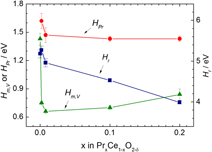Crossref Citations
This article has been cited by the following publications. This list is generated based on data provided by
Crossref.
Kuru, Y.
Marrocchelli, D.
Bishop, S. R.
Chen, D.
Yildiz, B.
and
Tuller, H. L.
2012.
Anomalous Chemical Expansion Behavior of Pr0.2Ce0.8O2-δThin Films Grown by Pulsed Laser Deposition.
Journal of The Electrochemical Society,
Vol. 159,
Issue. 11,
p.
F799.
Tuller, Harry L.
2013.
Materials for high temperature electrochemical applications: Automotive sensors, catalysts and traps.
Sensors and Actuators B: Chemical,
Vol. 187,
Issue. ,
p.
106.
Chen, Di
Bishop, Sean R.
and
Tuller, Harry L.
2013.
Non‐stoichiometry in Oxide Thin Films: A Chemical Capacitance Study of the Praseodymium‐Cerium Oxide System.
Advanced Functional Materials,
Vol. 23,
Issue. 17,
p.
2168.
Kuhn, M.
Bishop, S.R.
Rupp, J.L.M.
and
Tuller, H.L.
2013.
Structural characterization and oxygen nonstoichiometry of ceria-zirconia (Ce1−xZrxO2−δ) solid solutions.
Acta Materialia,
Vol. 61,
Issue. 11,
p.
4277.
Slostowski, Cédric
Marre, Samuel
Bassat, Jean-Marc
and
Aymonier, Cyril
2013.
Synthesis of cerium oxide-based nanostructures in near- and supercritical fluids.
The Journal of Supercritical Fluids,
Vol. 84,
Issue. ,
p.
89.
Harada, Koichiro
Oishi, Tetsuya
Hamamoto, Seiji
and
Ishihara, Tatsumi
2014.
Lattice Oxygen Activity in Pr- and La-Doped CeO2for Low-Temperature Soot Oxidation.
The Journal of Physical Chemistry C,
Vol. 118,
Issue. 1,
p.
559.
Kim, Jae Jin
Bishop, Sean R.
Thompson, Nicholas J.
Chen, Di
and
Tuller, Harry L.
2014.
Investigation of Nonstoichiometry in Oxide Thin Films by Simultaneousin SituOptical Absorption and Chemical Capacitance Measurements: Pr-Doped Ceria, a Case Study.
Chemistry of Materials,
Vol. 26,
Issue. 3,
p.
1374.
Chen, Di
Bishop, Sean R.
and
Tuller, Harry L.
2014.
Nonstoichiometry in Oxide Thin Films Operating under Anodic Conditions: A Chemical Capacitance Study of the Praseodymium–Cerium Oxide System.
Chemistry of Materials,
Vol. 26,
Issue. 22,
p.
6622.
Andersson, Annika K. E.
Selbach, Sverre M.
Knee, Christopher S.
Grande, Tor
and
Menon, M.
2014.
Chemical Expansion Due to Hydration of Proton‐Conducting Perovskite Oxide Ceramics.
Journal of the American Ceramic Society,
Vol. 97,
Issue. 8,
p.
2654.
Bishop, S.R.
Marrocchelli, D.
Chatzichristodoulou, C.
Perry, N.H.
Mogensen, M.B.
Tuller, H.L.
and
Wachsman, E.D.
2014.
Chemical Expansion: Implications for Electrochemical Energy Storage and Conversion Devices.
Annual Review of Materials Research,
Vol. 44,
Issue. 1,
p.
205.
Chen, Yubo
Zhou, Wei
Ding, Dong
Liu, Meilin
Ciucci, Francesco
Tade, Moses
and
Shao, Zongping
2015.
Advances in Cathode Materials for Solid Oxide Fuel Cells: Complex Oxides without Alkaline Earth Metal Elements.
Advanced Energy Materials,
Vol. 5,
Issue. 18,
Sahini, M. G.
Tolchard, J. R.
Wiik, K.
and
Grande, T.
2015.
High temperature X-ray diffraction and thermo-gravimetrical analysis of the cubic perovskite Ba0.5Sr0.5Co0.8Fe0.2O3−δ under different atmospheres.
Dalton Transactions,
Vol. 44,
Issue. 23,
p.
10875.
Sheth, J.
Chen, D.
Kim, J. J.
Bowman, W. J.
Crozier, P. A.
Tuller, H. L.
Misture, S. T.
Zdzieszynski, S.
Sheldon, B. W.
and
Bishop, S. R.
2016.
Coupling of strain, stress, and oxygen non-stoichiometry in thin film Pr0.1Ce0.9O2−δ.
Nanoscale,
Vol. 8,
Issue. 36,
p.
16499.
Swallow, Jessica G.
Kim, Jae Jin
Kabir, Mukul
Smith, James F.
Tuller, Harry L.
Bishop, Sean R.
and
Van Vliet, Krystyn J.
2016.
Operando reduction of elastic modulus in (Pr, Ce)O2− thin films.
Acta Materialia,
Vol. 105,
Issue. ,
p.
16.
Shao, Zongping
and
Tadé, Moses O.
2016.
Intermediate-Temperature Solid Oxide Fuel Cells.
p.
59.
Kim, Jae Jin
Bishop, Sean R.
Chen, Di
and
Tuller, Harry L.
2017.
Defect Chemistry of Pr Doped Ceria Thin Films Investigated by in Situ Optical and Impedance Measurements.
Chemistry of Materials,
Vol. 29,
Issue. 5,
p.
1999.
Swallow, Jessica G.
Kim, Jae Jin
Maloney, John M.
Chen, Di
Smith, James F.
Bishop, Sean R.
Tuller, Harry L.
and
Van Vliet, Krystyn J.
2017.
Dynamic chemical expansion of thin-film non-stoichiometric oxides at extreme temperatures.
Nature Materials,
Vol. 16,
Issue. 7,
p.
749.
Sheth, Jay
Chen, Di
Tuller, Harry L.
Misture, Scott T.
Bishop, Sean R.
and
Sheldon, Brian W.
2017.
Role of grain size on redox induced compositional stresses in Pr doped ceria thin films.
Physical Chemistry Chemical Physics,
Vol. 19,
Issue. 19,
p.
12206.
Anirban, Sk.
and
Dutta, Abhigyan
2017.
Structural interpretation of optical properties and ion transport mechanism in mixed valent Pr containing nanoceria.
Materials Research Bulletin,
Vol. 86,
Issue. ,
p.
119.
Michel, Kathrin
Eufinger, Jens-Peter
Ulbrich, Gregor
Lerch, Martin
Janek, Juergen
and
Elm, Matthias T.
2017.
Combining two redox active rare earth elements for oxygen storage – electrical properties and defect chemistry of ceria–praseodymia single crystals.
Physical Chemistry Chemical Physics,
Vol. 19,
Issue. 27,
p.
17661.

 ) regime and as such serve as model systems for investigating the correlation between thermodynamic and kinetic properties as well as exhibiting high performance figures of merit in the above applications. In this paper, we extend recently published results for Pr0.1Ce0.9O2−δ to include values of x = 0, 0.002, 0.008, 0.1, and 0.20 (in PrxCe1−xO2−δ) to test how both defect and transport parameters depend on Pr fraction. Important observed trends with increasing x include increases in oxygen ion migration energy and MIEC and reductions in vacancy formation and Pr ionization energies. The implications these changes have for potential applications of PrxCe1−xO2−δ are discussed.
) regime and as such serve as model systems for investigating the correlation between thermodynamic and kinetic properties as well as exhibiting high performance figures of merit in the above applications. In this paper, we extend recently published results for Pr0.1Ce0.9O2−δ to include values of x = 0, 0.002, 0.008, 0.1, and 0.20 (in PrxCe1−xO2−δ) to test how both defect and transport parameters depend on Pr fraction. Important observed trends with increasing x include increases in oxygen ion migration energy and MIEC and reductions in vacancy formation and Pr ionization energies. The implications these changes have for potential applications of PrxCe1−xO2−δ are discussed.

